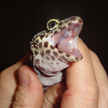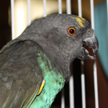
"Until one has loved an animal, a part of one's soul remains unawakened."
Animals

Bearded Dragon
G’Day, Mate! We Bearded Dragons are known for our sweet demeanor and easygoing attitude. All Bearded Dragons are diurnal, and don’t worry, we are non-venomous. At first glance, a bearded dragon can look quite intimidating, but that is part of our charm! If you look past our spiky exterior, you will see a gentle creature that will hang out on your shoulder for hours. We are omnivorous; we eat crickets, mealworms, and lettuce. We are famous! Can you guess what movie we played in for being a venomous “yellow-spotted lizard”?
Average Lifespan: 10-12 years

Corn Snake
We are also known as Rat Snakes, and we’re very popular in the snake trade. We corn snakes help to control rodent populations that may spread disease. We LOVE mice. We are constrictors, which means we bite our prey, then draw it into the center of our bodies and squeeze the life out of it before swallowing it whole! We are voracious eaters and love to pursue our prey. No frozen-thawed mice for us! We are otherwise non-aggressive, but food is a very serious business to us!
Average Lifespan: 10-15 years

Blue Tongue Skink
From Australia, we use mimicry to protect ourselves from predators. Since our legs are very small and our bellies drag the ground, it’s easier to pretend to be a snake rather than a lizard. When threatened or scared, we hiss like a snake. We are omnivorous, eating both insects and plants. We are also diurnal.
Average Lifespan: 10-20 years

Crested Gecko
Before 1994, scientists thought the Crested Gecko was extinct. But we were just hiding! We are nocturnal, and we have large, striking eyes so we can see at night. Our prehensile tail helps us hang upside-down. But unlike some other lizards, if we lose our tail, it will never grow back. We love to eat crickets and sometimes baby food! We are now thriving in captivity and in New Caledonia, off the coast of Australia. We can lick our own eyeballs! Can you?
Average Lifespan: 7-10 years

European Legless Lizard
Am I a snake or a lizard? Oftentimes, legless lizards are mistaken for snakes. Don\'t let me fool you! That\'s what we want you to think! If you look closely, you will see that I have eyelids and ear holes, whereas a snake has neither. My tail is also about half of my body; a snake\'s is only a few inches long. I can even drop my tail if I have to! (But please don’t pull it off, it hurts, and I might need it later) Tails sometimes grow back, but they will never be as pretty or as natural as our original ones. In my natural habitat in the European grasslands, I spin and hiss to make predators think I’m scary. I am a crepuscular (active at dusk and before dawn) or nocturnal ground dwellers. We can swim and climb trees, but only when we have to. Normally, I keep to myself, spending the daylight hours sunning myself on rocks or tree limbs. Rather than lying in ambush for prey to pass by, we European legless lizards are active predators that scour the forest floor in search of food. We can use our nose to burrow under leaves or under ground.
Average Lifespan: 15-20 years

Leopard Gecko
Hi! My name is India, and I am one of the most commonly bred lizards because I come in a variety of sizes and colors. I love to prowl around at night and eat crickets, mealworms, and sometimes the occasional pinky mouse. Yum! Feel my tail! That’s where I store all my fat for later! It can come off, but it’s painful and won’t grow back the same. So please don’t pull it off. Full grown, I can reach about 9 inches in length. And if you hold me up to a light, you can see right through my head!
Average lifespan: 20 years

Box Turtle
Ornate box turtles have been found to be more carnivorous than other box turtles. In their natural habitat, places like Wyoming and Nebraska, these critters evolved on the plains and one of their preferred food sources was beetles and grubs in bison dung. Yes, bugs in poop!

Chinchilla
This creature is definitely adorable. However, special care is needed for chinchillas and unfortunately, this is an animal that is often an impulse buy for people who do not know what they are getting into. Chinchillas live an average of 20 years, take baths in dust, and must be kept in temperatures below 75 degrees. Use extreme caution when thinking about purchasing one of these little guys.

Meyer's Parrot
This is a beautiful little parrot originating in Africa. They are known to be rather quiet and easygoing. Nahla came to us after we rescued her a year ago. Her case was severe. She was kept in a cage about the size of two shoeboxes. We saw her and knew she needed to come home with us. She has a few missing toes and would lunge and bite at us when she first arrived. Over time, she has become a very important part of our family. She now takes showers with us, walks in the neighborhood and of course, she visits with children during programs. She loves to smother us in kisses and chatter sweet noises in our ears.

Indian Walking Sticks
Also known as Stick Bugs. We are herbivores: we only eat leaves. 99.9% of us are girls! We don’t need males to lay eggs. We are nocturnal; so we are most active at night. We blend in better!
Average lifespan: 6 months - 1 year



